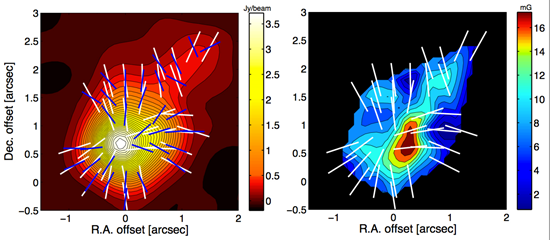Research Gallery > Star Formation Studies
Research Gallery
Star Formation Studies
| A New Method for Magnetic Field Strength Maps for Molecular Clouds |
|
Image Credit: Koch et al.

Left Figure: SMA dust continuum observation at 345 GHz of the star-forming core W51 e2 with a resolution of about 0.7 arcsec. The color-wedge indicates the dust emission intensity. The measured magnetic field morphology (white segments), shows that gravity is bending the field lines almost radially and pulling them toward the core center. Overlaid in blue are the intensity gradients of the dust emission. The correlation between field and intensity gradient orientations is used as a starting point in our method. Right Figure: Resulting field strength map for W51 e2. An increase in field strength toward the center is apparent.
|
| This paper reports on a new method to measure the strength of magnetic fields in molecular clouds, where stars are being formed. Understanding the details of star formation has been a challenge for decades. Magnetic fields are thought to play a key role in this process. Measuring the field strength is, thus, paramount to make quantitative assessments. Commonly used observational techniques provide either only one single averaged field strength for an entire star forming region, or they provide only isolated values (e.g. Zeeman observations). In all cases, valuable information is lost as the role of the field changes with location within a molecular cloud. In this work, we use dust polarization observations from the Submillimeter Array (SMA) at radio frequencies around 345 GHz for position-dependent estimates of the field strength. Dust particles couple to the field which is why coherent polarized emission can be detected. From the polarized emission we then derive the orientation of the magnetic field. Our method uses these field orientations in combination with changes (gradients) in dust densities. The geometry of these morphological features is then linked to magnetohydrodynamics equations, so that the field strength can be calculated. In this way, we are, for the first time, able to derive a field strength at every location where polarization is detected. Applied to the SMA observation of the W51 e2 core with a resolution of 0.7 arcsec, we find an increase in field strength from about 1 mG in the outer parts to about 10 mG in the center. Additionally, our method yields a model-independent force ratio which quantifies how effectively the field tension force withstands gravity. For W51 e2, we find that the field increases the collapse time by a factor of about 10, making the magnetic field a promising candidate to explain the observed low star formation efficiencies. |
 asiaa.sinica.edu.tw Media Request: epo
asiaa.sinica.edu.tw Media Request: epo asiaa.sinica.edu.tw
asiaa.sinica.edu.tw 